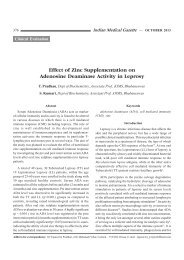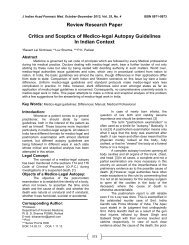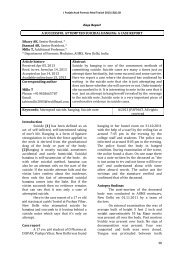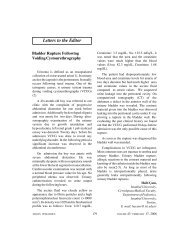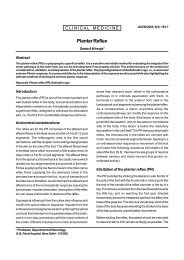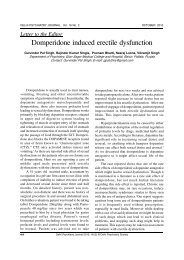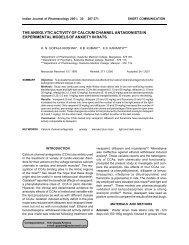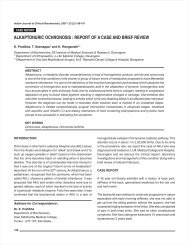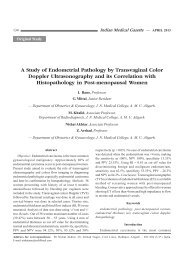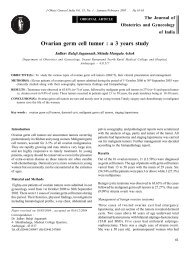Improving Positive Mental Wellbeing among Adolescents ... - medIND
Improving Positive Mental Wellbeing among Adolescents ... - medIND
Improving Positive Mental Wellbeing among Adolescents ... - medIND
Create successful ePaper yourself
Turn your PDF publications into a flip-book with our unique Google optimized e-Paper software.
DELHI PSYCHIATRY JOURNAL Vol. 15 No.1 APRIL 2012<br />
Review Article<br />
<strong>Improving</strong> <strong>Positive</strong> <strong>Mental</strong> <strong>Wellbeing</strong><br />
<strong>among</strong> <strong>Adolescents</strong>: Current need<br />
“I am stressed out” is a phrase that has been<br />
echoed by teens down through the ages. The level<br />
of stress experienced by teens on a daily basis has<br />
been described in lay and professional literature.<br />
Adults often underestimate this level of stress and<br />
may not always be cognizant of the potential<br />
consequences of stress on teens and young adults.<br />
This lack of appreciation of the stress experienced<br />
by adolescents may be partially related to a lack of<br />
awareness of the sources of stress in teen life, the<br />
changing nature of stressors through time, the everevolving<br />
complexities of adolescent life, and the<br />
tendency for adults to minimize their own personal<br />
stress during the teen years or compare their teen<br />
years to the experiences of others. Physiological<br />
development, cognitive differences, pubertal<br />
changes, immature coping mechanisms, slower<br />
recovery from stressful events, and lack of<br />
experience in dealing with stress may intensify the<br />
stressful events experienced by adolescents 1 .<br />
Teens can experience a spectrum of stresses<br />
ranging from ordinary to severe 2 . Stress has been<br />
associated with a variety of high-risk behaviors,<br />
including smoking, suicide, depression, drug abuse,<br />
behavioral problems, and participating in high-risk<br />
sexual behaviors 3,4 . In addition, long-term exposure<br />
to stress is associated with a variety of chronic<br />
psychological and physical illnesses. High-risk<br />
teens, or those who live in social disadvantage, may<br />
be at increased risk for illness related to chronic<br />
exposure to stress, discrimination, stigma, and a<br />
“harsh social environment” 5 . It has also been<br />
purported by the researchers that assessing<br />
adolescent stressors and the impact of stress is the<br />
first step in the prevention and treatment of its<br />
associated chronic diseases 6 .<br />
22<br />
LR Anuradha 1 , Yagnik 2 , Vibha Sharma 3<br />
1,2 Department of Psychology, S.P. University, Vallabh Vidyanagar (Gujarat)<br />
3 Department of Clinical Psychology, IHBAS, Delhi<br />
Delhi Psychiatry Journal 2012; 15:(1) © Delhi Psychiatric Society<br />
The latest research work showed a clear<br />
increase in stress consequences for adolescent<br />
related to experience, behavior and health (<strong>among</strong><br />
other things, fear to fail and psychosomatic<br />
disorders). In contrast, only a few stress handling<br />
programmes are available specifically for<br />
adolescents; a large part covers stress handling<br />
training courses orientated to behavior and<br />
cognition.<br />
<strong>Adolescents</strong> of today’s world are living in a<br />
world of competition and there is cut throat<br />
competition in every sphere of life. The theory of<br />
“SURVIVAL OF THE FITTEST” applies to each<br />
and every walk of the society. Adolescent today are<br />
living in an increasingly anxiety ridden atmosphere<br />
. In today’s competitive world, it is not uncommon<br />
to find academic achievement playing the most<br />
important role in an adolescent’s growing up. Being<br />
academically successful and making a place for<br />
oneself in the society is their priority.<br />
Social problems can be a significant stressor<br />
for adolescents. Disturbed youth often experience<br />
negative outcomes to social problems, solve<br />
problems poorly, and display distortions in<br />
reasoning about social problems. The social<br />
experiences of adolescence have an impact on<br />
identity formation. Peer pressure to use drugs or<br />
have intercourse can affect a teen’s life in significant<br />
ways, depending on the behavioral choices made<br />
in response to these social problems. Recent<br />
incidents of school shootings and the high rate of<br />
teen suicide underscore the potentially devastating<br />
outcomes of ineffective social problem solving.<br />
Disturbed adolescents were found more likely<br />
to select negative alternatives to social problems<br />
such as alcohol abuse, isolation, and running away
DELHI PSYCHIATRY JOURNAL Vol. 15 No.1 APRIL 2012<br />
from home. Disturbed youth with internalizing<br />
problems such as stress, depression, anxiety,<br />
loneliness, and social withdrawal perceive and<br />
process social problems differently from those who<br />
are normal or those with externalizing problems<br />
such as aggression. Depressed adolescents were<br />
found more likely to select negative alternatives to<br />
social problems such as alcohol abuse, isolation,<br />
and running away from home.<br />
Internalizing problems have been associated<br />
with cognitive distortions in perceiving and solving<br />
social problems, including selective abstraction,<br />
personalizing, overgeneralization, and catastrophizing<br />
7 . Involvement in prosocial activities is a<br />
protective factor against problem drinking <strong>among</strong><br />
teenagers 8 .<br />
Various stresses and their impact on life of an<br />
adolescent can be understood with the help of the<br />
following diagram. The figure shows the<br />
consequences of stress <strong>among</strong> adolescent which<br />
makes them highly vulnerable and they are at high<br />
risk to face various physical, psychological and<br />
social problems in life.<br />
<strong>Mental</strong> health problems affect 10—20% of<br />
children and adolescents worldwide. Despite their<br />
relevance as a leading cause of health-related<br />
disability in this age group and their long lasting<br />
effects throughout life, the mental health needs of<br />
children and adolescents are neglected, especially<br />
in low-income and middle-income countries.<br />
<strong>Mental</strong> Health and <strong>Wellbeing</strong> in Adolescence<br />
<strong>Mental</strong> health is an essential part of holistic<br />
wellbeing. The general well-being of adolescents<br />
has been the topic of considerable debate in recent<br />
years. Evidence has suggested that the current level<br />
of behavioral and emotional problems in teenagers<br />
is higher than in the past.<br />
<strong>Mental</strong> health is a way of describing social and<br />
emotional wellbeing. Good mental health is central<br />
to the adolescent’s healthy development. It is<br />
associated with:<br />
• Feeling happy and positive about yourself<br />
and enjoying life<br />
• Healthy relationships with family and<br />
friends<br />
• Participation in physical activity and eating<br />
a healthy diet<br />
• The ability to relax and to get a good night’s<br />
sleep<br />
• Community participation and belonging.<br />
Risk and Protective Factors of Adolescent’s<br />
<strong>Mental</strong> Health<br />
A mental health risk factor is an internal (e.g.<br />
temperament) or external (e.g. environment) condition<br />
that increases the likelihood of the development<br />
of a mental health problem. Alternatively, a mental<br />
health protective factor is an internal or external<br />
condition that mitigates against the development<br />
of mental health problems and helps to promote<br />
resiliency.<br />
While no single risk factor can predict the<br />
development of mental illness nor any single<br />
protective factor assure immunity, the following<br />
chart identifies risk and protective factors that are<br />
known to correlate with mental health functioning<br />
in children and youth. 9<br />
Delhi Psychiatry Journal 2012; 15:(1) © Delhi Psychiatric Society 23
DELHI PSYCHIATRY JOURNAL Vol. 15 No.1 APRIL 2012<br />
<strong>Mental</strong> Health Risk Factors <strong>Mental</strong> Health Protective Factors<br />
Individual Factors<br />
Prenatal brain damage Easy temperament<br />
Prematurity Adequate nutrition<br />
Birth injury Above average intelligence<br />
Low intelligence Problem solving skills<br />
Chronic illness Internal locus of control<br />
Poor health in infancy Social competence<br />
Insecure attachment in infancy/childhood Social skills<br />
Low birth weight, birth complications Good coping style<br />
Difficult temperament Optimism<br />
Physical and/or intellectual disability Moral beliefs<br />
Poor social skills Values<br />
Low self-esteem <strong>Positive</strong> self regard<br />
Impulsivity Good physical health<br />
Family Factors<br />
Absence of either parent in childhood Attachment to family<br />
Anti-social role models Supportive, caring parents<br />
Marital discord in parents, divorce Family harmony<br />
Long term parental unemployment Secure and stable family<br />
Parental criminality and disharmony Small family size<br />
Parental substance abuse More than 2 years between siblings<br />
Parental mental health disorder High level of family responsibility<br />
Poor supervision and monitoring Strong family norms and morality<br />
Family social isolation Economic security<br />
Lack of warmth and affection<br />
Death of a family member<br />
School Factors<br />
Poor attachment to school School achievement<br />
Bullying Sense of belonging at school<br />
Peer rejection <strong>Positive</strong> school climate<br />
Inadequate behavior mgmt Pro-social peer group<br />
Deviant peer group High expectations<br />
School failure Required responsibility & service to others<br />
Frequent school transitions Opportunities for success & recognition of<br />
achievement<br />
Community and Cultural Factors<br />
Socio-economic disadvantage Sense of connectedness to community<br />
Social /cultural discrimination Attachment to community networks<br />
Neighborhood violence &crime Strong cultural identity and ethnic pride<br />
Overcrowded housing conditions Access to support services<br />
Lack of recreational opportunities Community norms against violence<br />
Lack of support services Caring neighborhood<br />
24<br />
Delhi Psychiatry Journal 2012; 15:(1) © Delhi Psychiatric Society
DELHI PSYCHIATRY JOURNAL Vol. 15 No.1 APRIL 2012<br />
Adolescent mental health is a concern for<br />
health professionals as the prevalence of mental<br />
health problems appears to peak in adolescence and<br />
early adulthood because of the biological and<br />
psychosocial transitions that are occurring in this<br />
age group. Adolescence is a major transitional<br />
period between childhood and adulthood and many<br />
changes—physical, emotional and social—occur<br />
during this time. These changes can precipitate and<br />
perpetuate mental health difficulties in young<br />
people. Due to the amount of changes that occur in<br />
adolescence, younger and older adolescents are at<br />
quite distinct life stages and are biologically,<br />
cognitively, socially and emotionally distinct. There<br />
are also differences between younger and older<br />
adolescents in the prevalence of different disorders<br />
and in how they express their difficulties. It is,<br />
therefore, important for healthcare professionals to<br />
be mindful of the development level of the<br />
adolescents with whom they are working and the<br />
impact that this can have on the young person’s<br />
presentation, understanding of their problems and<br />
in their ability to use different therapeutic<br />
interventions.<br />
<strong>Mental</strong> wellbeing can be improved<br />
The <strong>Mental</strong> wellbeing can be improved by<br />
focusing on the fundamentals of the way we live<br />
our life. It is not just whether we are exercising,<br />
eating well and not getting stressed, but what is<br />
underneath that impacts on the real change. The<br />
<strong>Mental</strong> <strong>Wellbeing</strong> Model takes into account existing<br />
and new research and suggests the following stages<br />
to wellbeing:<br />
Values<br />
The rules by which one live one’s life, the very<br />
core of one’s being. It is values that affect the<br />
decisions we make, the life choices and how we<br />
respond to situations we experience.<br />
Beliefs<br />
Figure-2. <strong>Mental</strong> <strong>Wellbeing</strong> Model<br />
These are more than beliefs in the religious<br />
sense; it is something that we believe to be true<br />
about ourselves and about the world that we live<br />
in. Beliefs are fundamental in either helping or<br />
hindering us to achieve what we want from life.<br />
Delhi Psychiatry Journal 2012; 15:(1) © Delhi Psychiatric Society 25
DELHI PSYCHIATRY JOURNAL Vol. 15 No.1 APRIL 2012<br />
Goals/Life Purpose<br />
This is the target we are aiming for and<br />
ultimately, what we need to do in our lives to feel<br />
fulfilled. Someone living to their life purpose will<br />
have their beliefs, values and goals aligned and are<br />
in accordance with how they want to live their life,<br />
it is at the very cornerstone of wellbeing.<br />
Cognitions<br />
This is the way we collect, store and process<br />
information. It is about the mood we wake up with<br />
in the morning and how we manage ourselves during<br />
the day, what emotions we are holding and whether<br />
they are serving us well. Happier people tend to<br />
have healthier lifestyles 9 , more friends, and also<br />
more positive interpersonal experiences” 10 .<br />
Emotional Intelligence<br />
Emotional intelligence as described refers to<br />
our ability to manage our emotions, respond to the<br />
emotions of others and how we emotionally cope<br />
with life. It affects our ability to stay resourceful,<br />
build and improve successful relationships, manage<br />
ourselves and to create the conditions of happiness,<br />
success and fulfillment in our lives.<br />
These points have been briefly explained with<br />
the help of <strong>Mental</strong> Well Being Model. In which the<br />
inter-connectedness of the above mentioned stages<br />
has been depicted to achieve the ultimate goal of<br />
<strong>Mental</strong> Well Being through developing ongoing<br />
processes viz. Personal Growth, Self Acceptance,<br />
Personal Relations & Environmental Mastery.<br />
The area of mental health has long been debated<br />
and is not a simple field to understand, there is not<br />
only the impact of mental wellbeing but also illbeing.<br />
<strong>Wellbeing</strong> is about alignment and that is<br />
exactly what coaching does, it takes account of the<br />
whole life and bases goals on this. Through<br />
improved intelligence around your emotions, beliefs<br />
and values, you can set meaningful goals, align<br />
yourself to your life purpose and as a result, you<br />
will then achieve the ways to wellbeing: you will<br />
know how to connect with others and benefit from<br />
the exchange, you can achieve your physical<br />
wellbeing goals, you will be more aware of yourself<br />
and others around you, you will be better placed to<br />
learn from your experiences and take on additional<br />
learning should you choose, and you will be more<br />
accepting of yourself and able to give to others as a<br />
26<br />
result.<br />
Importance of Promoting Adolescent <strong>Mental</strong><br />
Well Being<br />
In the short term:<br />
Delhi Psychiatry Journal 2012; 15:(1) © Delhi Psychiatric Society<br />
Interrupting poor mental health as soon as<br />
possible in the childhood and adolescent years will<br />
reap instant rewards for young people. Those who<br />
are supported and have more positive mental health<br />
can learn better and are more likely to fulfill their<br />
social, academic and training potential. It is likely<br />
that intervening more effectively and imaginatively<br />
could significantly reduce adolescent mortality<br />
(through reducing suicide rates) and improve life<br />
experiences. If we can accurately assess mental<br />
health problems, and we know both how to<br />
intervene and also that intervention may work, then<br />
there is an ethical imperative to do something as<br />
soon as we can.<br />
In the longer-term<br />
Enhancing health and educational outcomes<br />
will benefit young people in the shorter term, but<br />
will of course benefit all of us in the longer term as<br />
well. A significant proportion of young people with<br />
mental health problems will go on to be adults with<br />
not just ongoing mental health problems, but also<br />
range of other poor outcomes as well – difficulties<br />
with relationships, unstable employment histories,<br />
involvement in crime, and social exclusion.<br />
Research has shown that by age 28, people with<br />
continuing high levels of antisocial behavior have<br />
cost society up to 10 times more than those with no<br />
problems – these are the costs of public services<br />
such as extra educational provision, foster and<br />
residential care, and unemployment benefits, quite<br />
apart from the personal costs to the individual (11) .<br />
References<br />
1. Denise EL, Herrman J. Adolescent stress<br />
through the eyes of high-risk teens. Pediatr<br />
Nurs 2008.<br />
2. Lau BWK. Does the stress of child-hood and<br />
adolescence matter? A psychological perspective.<br />
J Royal Soc Promotion Health 2002;<br />
122(4) : 238-244.<br />
3. Finkelstein DM, Kubzansky LD, Capitman J,<br />
and Goodman E. Socioeconomic differences in<br />
adolescent stress: The role of psychological
DELHI PSYCHIATRY JOURNAL Vol. 15 No.1 APRIL 2012<br />
resources. J Adolesc Health 2007; 40(2) : 127-<br />
134.<br />
4. Finkelstein DM, Kubzansky LD, Goodman E.<br />
Social status, stress, and adolescent smoking. J<br />
Adolesc Health 2006; 39(5) : 678-675.<br />
5. Goodman E, McEwen BS, Dolan LM et al.<br />
Social disadvantage and adolescent stress. J<br />
Adolesc Health 2005; 37 : 484-492.<br />
6. Chandra A, Batada A. Exploring stress and<br />
coping <strong>among</strong> urban African-American<br />
adolescents: The shifting the lens study.<br />
Preventing Chronic Disease: Public Health Res<br />
Practice Policy 2006; 3(2) : 1-10.<br />
7. Leung PW, Wong MM. Can cognitive distortions<br />
differentiate between internalising and<br />
externalising problems? J Child Psychol<br />
Psychiatry 1998; 39 : 263-269.<br />
8. Costa FM, Jessor R, Turbin MS. Transition into<br />
adolescent problem drinking: the role of<br />
psychosocial risk and protective factors. J<br />
Studies Alcohol Drugs 1999; 60(4) : 480-90.<br />
9. Watson D, Clark LA, Tellegen A. Development<br />
and validation of brief measures of positive and<br />
negative affect: The PANAS scales. J Personal<br />
Soc Psychol 1988; 54 : 1063–1070.<br />
10. Diener Ed, Eunkook M, Suh, Robert E. Lucas<br />
and Heidi L. Smith. ‘Subjective Well-Being:<br />
Three Decades of Progress.’ Psychol Bull 1999;<br />
125 (2) : 276-302.<br />
11. Scott S et al. Financial cost of social exclusion:<br />
follow-up study of antisocial children into<br />
adulthood. Br Med J 2001; 323 : 191–196.<br />
Delhi Psychiatry Journal 2012; 15:(1) © Delhi Psychiatric Society 27



